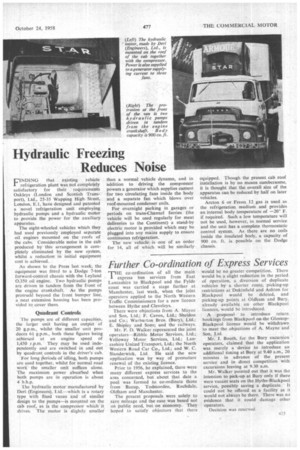Hydraulic Freezing Reduces Noise
Page 59

If you've noticed an error in this article please click here to report it so we can fix it.
"I'INDING that existing vehicle 1 refrigeration plant was not completely satisfactory for their requirements Oakleys (London and Scottish Transport), Ltd., 25-35 Wapping High Street, London, E.1, have designed and patented a novel refrigeration unit employing hydraulic pumps and a hydraulic motor to provide the power for the auxiliary apparatus.
The eight-wheeled vehicles which they had used previously 'employed separate oil engines mounted on the roofs of the cabs. Considerable noise in the cab produced by this arrangement is completely eliminated by the new system, whilst a reduction in initial equipment cost is achieved.
As shown to the Press last week, the equipment was fitted to a Dodge 7-ton forward-control chassis with the Leyland 0.350 oil engine. Two hydraulic pumps are driven in tandem from the front of the engine crankshaft. As the pumps protrud beyond the front bumper line, a neat extension housing has been provided to cover them.
Quadrant Controls
The pumps are of different capacities, the larger unit having an output of 20 g.p.m., whilst the smaller unit produces 64 g.p.m., both these figures being achievgd at an engine speed of 1,450 r.p.m. They may be used inde pendently and are switched in and out by quadrant controls in the driver's'eab.
For long rleriods of idling, both pumps are used together, whilst for normal road work the smaller unit suffices alone. The maximum power absorbed when both pumps are in operation is about 4 b.h.p.
The hydraulic motor manufactured by Den i (Engineers), Ltd.—which is a rotary type with fixed vanes and of similar design to the pumps—is mounted on the cab roof, as is the compressor which it drives. The motor is slightly smaller than a normal vehicle dynamo, and in addition to driving the compressor powers a generator which supplies current for two circulating fans inside the body and a separate fan which blows over roof-mounted condenser coils.
For overnight parking in garages or periods on trans-Channel ferries (the vehicle will be used regularly for meat deliveries to the Continent) a stand-by electric motor is provided which may be plugged into any mains supply to ensure continuous refrigeration.
The new vehicle is one of an order for 14, all of which will be similarly equipped. Though the present cab roof installation is by no means cumbersome, it is thought that the overall size of the apparatus can be reduced by half on later vehicles.
Arcton 6 or Freon 12 gas is used as the refrigeration medium and provides an internal body temperature of —20° F. if required. Such a low temperature will not be used, however, in normal service and the unit has a complete thermostatic control system. As there are no coils inside the insulated body, a capacity of 900 Cu. ft. is possible on the Dodge chassis.




































































































